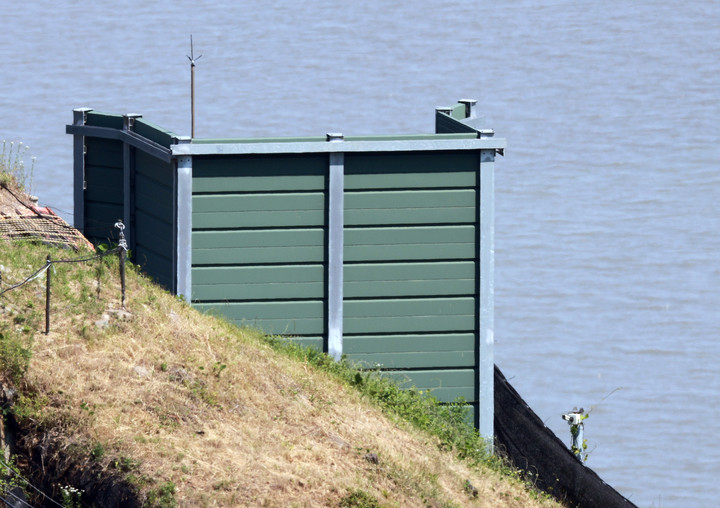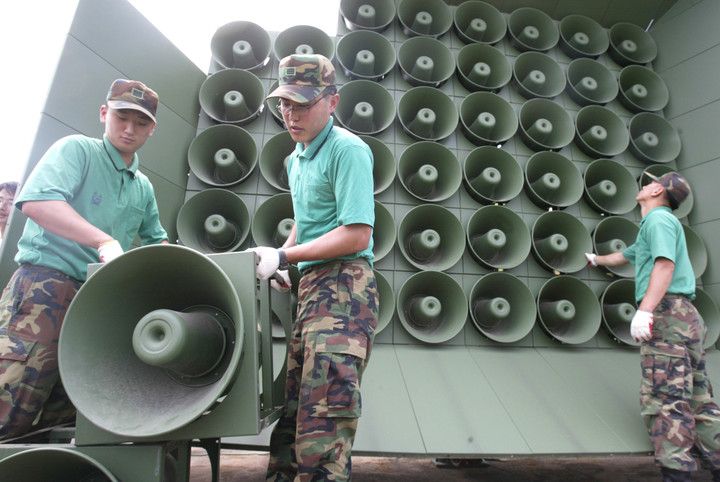South Korean military begins dismantling anti-North loudspeakers to ease border tensions
Opposition voices strong criticism, raising concerns over security implications and “second balloon incident”

On August 4, South Korea’s military began the process of dismantling anti-North Korea loudspeakers positioned along the inter-Korean border, in line with President Lee Jaemyeong’s call for “restoring trust between the two Koreas.”
The Ministry of National Defense confirmed the operation, stating, “We are implementing tangible measures to de-escalate inter-Korean tensions without compromising our readiness posture.” This follows a full suspension of loudspeaker broadcasts on June 11, just days into President Lee’s term, as part of his administration’s efforts to revive trust with Pyongyang.
The armed forces had been operating roughly 40 loudspeakers—24 fixed and 16 mobile units—along the border. Following the broadcast halt, mobile loudspeakers were withdrawn from operation. Now, approximately 20 fixed installations are slated for removal. According to Deputy Spokesperson Lee Kyungho of the Defense Ministry, “After discussions among relevant departments, we decided on removal as a follow-up measure. There was no prior consultation with North Korea; this is a preemptive move made solely on our side.” The removal is expected to be completed within a few days, focusing on permanent installations, while the treatment of mobile units will depend on circumstances as they evolve.
North Korea, for its part, also ceased its propaganda broadcasts targeting the South after South Korea’s decision in June. The North has operated around 40 fixed loudspeakers; while signs of maintenance work have been observed, there is yet no evidence of similar removal operations.
“Our military remains fully vigilant and will respond based on military judgment as North Korea’s future responses are closely monitored,” emphasized the Ministry of National Defense.


‘Undermining Security, Not Building Trust’—Strong Opposition Critique
The decision has met fierce criticism from opposition parties, who have labeled the removal of loudspeakers a “self-destructive security measure.” Loudspeaker broadcasts targeting the North had resumed in 2023 under the Yoon Sukyeol administration, six years after they were last halted, as a response to North Korea’s balloon-based provocations. However, the Lee Jaemyeong administration quickly suspended the broadcasts within a week of taking office and has now moved to dismantle the installations after just 55 days, in line with a wider push to reduce tensions.
Members of the National Assembly’s Defense Committee, belonging to the People Power Party, issued a stern statement. “The suspension and removal have proceeded at breakneck speed, barely a week into the new administration,” argued Representative Sung Iljong and others. “It sounds as if Kim Jong Un himself is laughing at this turn of events,” they sharply criticized.
They added, “When similar loudspeaker removals took place during the Moon Jae-in administration, it resulted in the ‘waste balloon’ provocations and the destruction of the inter-Korean liaison office. The Lee Jaemyeong administration is repeating a failed policy.” The opposition further insisted that, rather than dismantling the loudspeakers, maintaining and managing them would have provided leverage in future dealings with North Korea, calling the move “self-harming.”
Criticism of President Lee’s North Korea policy has continued unabated. People Power Party lawmakers accused the Minister of Unification of “adjusting joint South Korea-U.S. military drills out of consideration for North Korea’s mood” and questioned, “Is this really a country if we cannot conduct exercises for fear of upsetting Pyongyang?” They further alleged, “The only ones to benefit from pandering to North Korea are President Lee Jaemyeong and the Democratic Party. Is this yet another event designed for electoral gain, as seen under the previous administration?”
Note “This article was translated from the original Korean version using AI assistance, and subsequently edited by a native-speaking journalist.”
Photo=Yonhap News Agency
추천 뉴스
- 1 Remembering Song Young-kyu: A Life Center Stage and Off On August 4th, news broke of the loss of another cherished actor. Rifling through an old reporter’s notebook, I am transported back fifteen years to the day I interviewed Song Young-kyu, who was just beginning to catch viewers’ attention as Go Jang-geun in SBS’s “Jejungwon.” I vividly recall him wis
- 2 The Return of the Original Heartthrob: How Ahn Jae-wook Revitalized KBS Weekend Dramas At a recent wedding for Koyote member Kim Jong-min, a surprising figure became the center of attention among a sea of top celebrities. Actor Ahn Jae-wook was greeted with enthusiastic applause, especially from older guests who bypassed other stars to shake his hand, hailing him as “The Chairman.” Th
- 3 Son Heung-min to Join LAFC, Ending a Decade with Tottenham Son Heung-min is set to officially end his ten-year journey with Tottenham Hotspur, as reports confirm his imminent transfer to LAFC.European football transfer specialist Fabrizio Romano announced on August 4 (Korean time): “Son Heung-min’s move to LAFC is imminent. All agreements are now finalized
- 4 Park Bo-gum Bids Farewell to 'The Seasons: Park Bo-gum’s Cantabile' With Tears and Sincerity When singer IU stepped onto the stage, declaring, "I came to keep my promise," MC Park Bo-gum, who had held his composure for five months, finally shed tears. The actor's journey as the host of a music talk show—an unprecedentedly long stint—ended amid warm camaraderie from fellow artists and enthus
- 5 Lotte Giants Pull Off Miracle Ninth-Inning Rally for Dramatic Victory Over Kiwoom Heroes The Lotte Giants delivered a drama-filled ninth-inning comeback to claim a thrilling 3-2 victory over the Kiwoom Heroes at Gocheok Sky Dome on August 2, in the 2025 Shinhan SOL Bank KBO League.Trailing 2-1 with two outs in the top of the ninth, Lotte launched a daring strategy by sending in consecut
- 6 Kim Yeon-koung Returns as Heungkuk Life Advisor, Delighting Volleyball Fans Kim Yeon-koung made a highly anticipated appearance at a fan meeting held at Cine Cube in Saemunan-ro, Jongno-gu, Seoul on August 2, where she shared personal reflections and updates following her recent retirement from professional volleyball.The event was organized to both commemorate Heungkuk Lif
- 7 Tottenham Captain Son Heung-min Bids Farewell After Decade, Leaving 173 Goals and 101 Assists Son Heung-min has announced his decision to leave Tottenham Hotspur after a remarkable 10-year run in the English Premier League, embarking on a new adventure after making his mark as one of Asia’s most successful footballers.Before the 2025 Coupang Play Series press conference held at The Forum at
- 8 Korean and Thai Curling Federations Sign MOU to Strengthen Global Cooperation and Sports Innovation The Korea Curling Federation announced on August 1 that it has entered into a memorandum of understanding with the Thailand Curling Federation at the Olympic House in Songpa-gu, Seoul, aimed at promoting joint development of the sport.Through this agreement, the two federations have committed to col
- 9 Ulsan HD and Coach Kim Pan-gon Part Ways After One Year Amid Performance Slump K League 1 side Ulsan HD has parted ways with head coach Kim Pan-gon just a year after his appointment, following a series of disappointing performances. The club officially announced on the 1st that Head Coach Kim had offered his resignation, taking responsibility for recent results, and that both
- 10 Mona Yongpyong to Host 2026 UCI MTB World Series, Marking First-Ever Event in Asia Mona Yongpyong announced on August 1st that it will host the 'UCI MTB World Series,' organized by the Union Cycliste Internationale (UCI), marking the first time in history that the mountain bike world cup competition will take place in Asia.The renowned event is scheduled for May 1 to 3, 2026, in t
